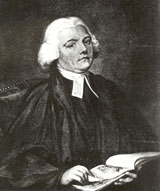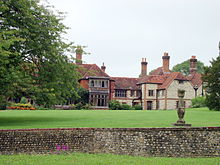Gilbert White
![]()
This article is about the English clergyman and naturalist. For the US-American geographer see Gilbert F. White.
Gilbert White FRS (born 18 July 1720 in Selborne, Hampshire; † 26 June 1793 there) was an English clergyman, naturalist and ornithologist. He remained an unmarried chaplain throughout his life and is best known for his book The Natural History and Antiquities of Selborne (1789). His official botanical author code is "G. White".
He grew up in his grandfather's vicarage at Selborne (6 km south of Alton (Hampshire) in the South Downs north of the present South Downs National Park), attended Holy Ghost School and received private tuition from a tutor in Basingstoke before studying at Oriel College, Oxford University. In 1746 he became a deacon and in 1749 he was ordained. He was then vicar (curate) in Hampshire and Wiltshire, including four times in Selborne itself and in the neighbouring parishes of Newton Valence and Farringdon (Hampshire), among others. In 1752/53 he was junior proctor at Oxford and dean (dean) of Oriel College. In 1757 he became permanent curate of Moreton Pinkney in Northamptonshire (without attendance). After his father's death in 1758 he moved to the family seat at The Wakes in Selborne, which he inherited in 1763. In 1784 he became curate of Selborne for the fourth time, which he remained until his death (he could not get the parish for life as it was connected with Magdalen College, Oxford, but he had studied at Oriel).
He kept a scientific diary covering 25 years from 1768 to 1793, which formed the basis of his book. His Natural History of Selborne is written in the form of letters to zoologist Thomas Pennant and lawyer and Royal Society member Daines Barrington (some of the letters were not sent but are stylistic devices). The book was, and still is, a bestseller and established its own genre of nature writing.
His sister Anne was married to the meteorologist Thomas Barker (1722-1809). White's records also contain evidence for the effects of the eruptions at the Laki Fissure on Iceland in 1783/84.
His family home, The Wakes, is now a museum.

Gilbert White
.jpg)
Cover page of the Natural History of Selborne
Works
- The natural history and antiquities of Selborne, in the county of Southampton. London 1813, doi:10.5962/bhl.title.35522 (with biographical data on pp. viii-ix), Project Gutenberg.

Gilbert White's house The Wakes, now a museum. Photograph taken from the garden side. (2010)
Questions and Answers
Q: Who was Gilbert White?
A: Gilbert White was an English naturalist and ornithologist.
Q: When was he born?
A: He was born on 18 July 1720.
Q: What did he do?
A: He was a pioneering naturalist and ornithologist.
Q: When did he die?
A: He died on 26 June 1793.
Q: Where did he live?
A: He lived in England.
Q: What type of scientist was he?
A: He was a naturalist and ornithologist.
Q: What is his legacy?
A: His legacy is that of a pioneering English naturalist and ornithologist who made significant contributions to the field of ecology and conservation.
Search within the encyclopedia